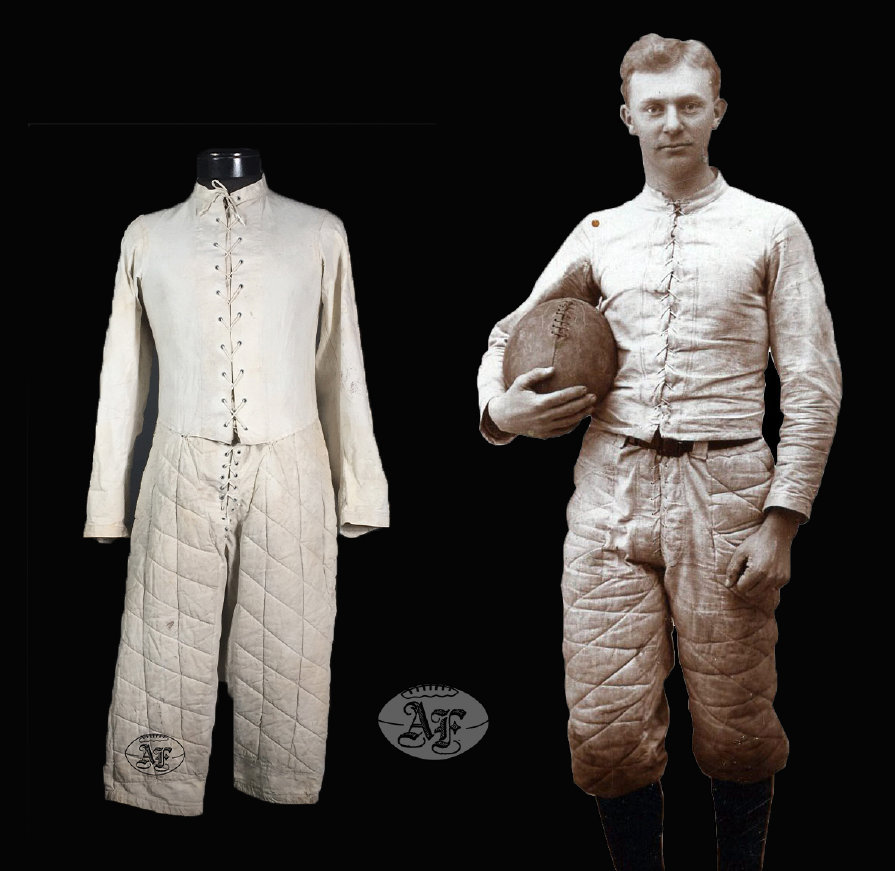









An industrious lot, American college players experimented with uniform alternatives to increase their advantage. Tired of repairing and replacing torn jerseys, in 1876 Ledru P. Smock "concluded to find some remedy for the evil." A Princeton freshman, Smock designed a canvas jacket that fit snug to his body and laced up his back, requiring a friend's assistance to "suit up." The jacket was remarkably effective at eliminating graspable surfaces on Smock's torso.
The following year, Princeton's first eleven suited up in canvas "Smock" jackets for the first time. Their advantages apparent, tight-fitting, lace-up uniforms would become a uniquely iconic symbol of the American game for the next 40 years. The canvas jacket not only impacted the evolution of football equipment, it changed the evolution of football itself. With the new uniforms, arm tackles and pulling the ball carrier to the ground became obsolete. Proper tackling techniques and disciplined defensive alignments moved to the forefront of team strategy and defined elite teams.
The following year, Princeton's first eleven suited up in canvas "Smock" jackets for the first time. Their advantages apparent, tight-fitting, lace-up uniforms would become a uniquely iconic symbol of the American game for the next 40 years. The canvas jacket not only impacted the evolution of football equipment, it changed the evolution of football itself. With the new uniforms, arm tackles and pulling the ball carrier to the ground became obsolete. Proper tackling techniques and disciplined defensive alignments moved to the forefront of team strategy and defined elite teams.
1876-1890 "The Foot Ball Smock Jacket"
The first organized "foot ball" contests in the United States were played by the rules of early forms of English association and rugby foot ball games. Game play was continuous, shifting fluidly between offense and defense with players playing on both sides of the ball without downs or substitutions. As a result, the earliest uniforms were identical to those worn in rugby matches, "a common long-sleeved jersey, an ordinary pair of long trousers, heavy walking shoes, and a skull cap [Rockland]." As in rugby, players could only tackle above the waist, and it was common for a player to grab and pull his opponent's jersey to assist in the tackle.

By the mid-1880's sporting goods dealers began offering mass-produced canvas and moleskin smock jackets and football pants to the public. While some football teams and players continued to wear wool jerseys, canvas jackets and padded pants were the dominant uniform style for college teams between 1885 and 1900. The monochromatic uniforms mandated the use of the skull cap as standard headgear on the football field. The skull cap enabled players to identify teammates and protected the ears against scrum abrasions and impacts.
Wright & Ditson Catalogue Games for In and Out Doors, 1888

The History of American Football's Earliest Headgear
Circa 1885-1890 Canvas Football Jacket & Quilted Pants
For more on this artifact, check out:
For more on the football cap, check out:
In all but the most elite Ivy-league schools, football uniforms were anything but....uniform. At most colleges and secondary schools, athletics weren't officially sanctioned and players were responsible for obtaining their own equipment. As a result, it was common for teammates to wear a plethora of different styles of jerseys, pants, caps, and jackets.
Many players elected to cutoff or remove the sleeves of the football jacket, for better comfort and range of motion. Removing the sleeves of the football jacket became so prevalent that in the early 1890's, Spalding and other football equipment manufacturers introduced the Foot Ball Jacket without sleeves; essentially a canvas "Smock" vest. As the nineteenth century came to a close, jackets were also available in other materials, including white duck and moleskin. While use of the smock vest would continue until the mid 1910's, it was overtaken by the union suit as the predominant uniform on the American football field by 1905.
Many players elected to cutoff or remove the sleeves of the football jacket, for better comfort and range of motion. Removing the sleeves of the football jacket became so prevalent that in the early 1890's, Spalding and other football equipment manufacturers introduced the Foot Ball Jacket without sleeves; essentially a canvas "Smock" vest. As the nineteenth century came to a close, jackets were also available in other materials, including white duck and moleskin. While use of the smock vest would continue until the mid 1910's, it was overtaken by the union suit as the predominant uniform on the American football field by 1905.
1885-1910 "The Foot Ball Smock Vest"